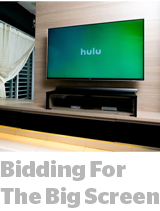 Hulu will switch to a first-price auction for its programmatic private marketplace next week.
Hulu will switch to a first-price auction for its programmatic private marketplace next week.
The streaming service told advertisers and tech partners of the shift in an email sent on Monday.
All the DSP partners in Hulu’s invite-only private marketplace will be certified to bid under the new auction terms.
Not all of Hulu’s inventory will be sold on first price, since there are programmatic deals with fixed rates and some guaranteed inventory that programmers sell in upfront packages. But the first-price marketplace does have access to the full Hulu supply, sources said, giving programmatic buyers a chance to bid high enough to win any given impression.
“By moving to a first-price auction, we’re cutting down on complicated rules, increasing transparency in the value exchange and giving advertisers even more control over their buys,” Hulu said in its note updating customers.
The move is hardly a surprise, according to one demand partner notified about the Hulu auction change. Amazon’s SSP Publisher Services and Google’s SSP Ad Manager already sell their OTT inventory via first-price auction, and it’s how programmatic exchanges have recently started selling display inventory.
What is surprising is the short notice Hulu is giving to advertisers, said another ad tech exec about the update.
Amazon didn’t have to make a transition from second-price auctions, because its video SSP came on relatively late, when buyers and exchanges had started operating on first price. Google tested first-price auctions for years and gave customers more than three months heads up before it flipped the switch.
Hulu has been internally evaluating auction dynamics since it introduced its private marketplace product earlier this year, said Asiya Vorontsova, VP of Business Intelligence for Telaria, Hulu’s excusive programmatic partner.
First-price dynamics are popular with publisher ops teams as more premium inventory has become available. The second-price auctions that once dominated online advertising originated with web banners and remnant inventory.
So web publishers have mostly transitioned to first price. And in advanced TV, where there’s limited supply and heavy demand, first-price deals are even more attractive.
Hulu is a rare exception in programmatic OTT because its content is primarily episodic shows that advertisers think of as “television,” compared to the short-form or social-style content on Roku channels, YouTube and Amazon Fire apps.
Vorontsova said the move to first-price auctions makes particular sense for Hulu.
Inventory quality has a way of being flattened in programmatic exchanges, where data and audiences stand out. The more clearly and transparently buyers value Hulu impressions compared to the wider programmatic video and CTV pool, the more Hulu stands to gain, she said.
Below is the full text of the note sent to Hulu customers:
“Hulu helped to usher in a new era for automated buying in OTT with the launch of our Advanced TV solution for advertisers in 2017. In order to continue our forward momentum and bring more automated capabilities to the living room, Hulu is moving to a first-price auction on Monday, October 14.
As the streaming OTT leader with the largest wholly addressable marketplace, we’re committed to driving the industry forward by enabling more efficient, transparent automated buying. Our move to a first-price auction is an important step for the entire OTT automated ecosystem.
Hulu’s invite-only auction gives advertisers more control over their automated buys, and with this change, advertisers will now pay the actual price they bid. By moving to a first-price auction, we’re cutting down on complicated rules, increasing transparency in the value exchange and giving advertisers even more control over their buys.
If you have any additional questions, please reach out to your Hulu Account Manager to schedule a call to discuss next steps.”













